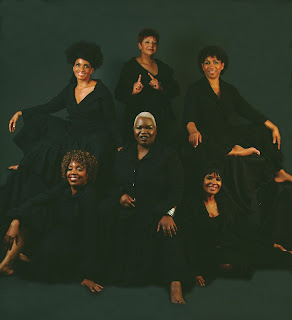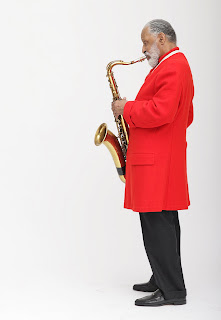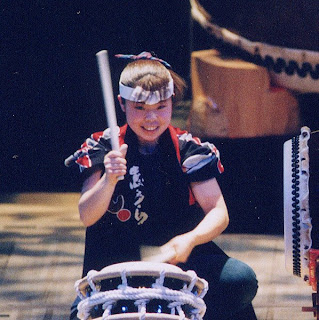Sweet Honey in the Rock April 22, 2008

Sweet Honey in the Rock: Harmony and Humanity
By Glen Creason
Exuding class, offering sweet optimism, fostering brotherhood and teaching important historical lessons in song, the excellent vocal group Sweet Honey in the Rock achieved perfect concert balance on Tuesday evening at the Performing Arts Center. These teachers of the great African-American cultural tradition have expanded their scope from early gospel-folk shows to encompass the entire planet in their repertoire. On this night, their great individual talents blended into a tapestry of song and story that really lifted up an entire auditorium for almost two hours. In these times of trouble Sweet Honey puts the emphasis on the possible and pointed the way to the future by showing us the lessons of the past where the great battles won have paved the way to today’s progress.
The old songs still resonate, as did “Somebody’s Callin’ My Name” which opened the set and gave notice to the many newcomers to these shows that the sound coming from just five women (and the sign language from another) can be as large and dramatic as a symphony. “Do What the Spirit Says Do” was another old time spiritual made pure and strong by the rousing rhythmic exhortation from Louise Robinson backed by the a-cappella accompaniment of her sister Sweet Honeys. These were not the only gospel-tinged tunes in the show, certainly the first half closing dynamite singing of “I’m Coming Home Someday” by Carol Maillard and Dr. Ysaye Barnwell’s superb narration and singing of “When I Die” was the kind of performance you feel in your bones. Each member of the ensemble is unique but Dr. Barnwell’s bass notes really make that Sweet Honey sound vibrate into your soul. There were also a couple of wonderful African tunes sung in pristine harmony, creating a soundscape that was amazing and full of color. “Denko” brought each member into a percussive whole while Nitanju Bolade Casel wailed a soulful vocal and the entire hall was used as chorus for the uplifting “Fulani Chant” that recognizes God in nature. Nature and Earth Day was further saluted by the exuberant emotional performance of Aisha Kahlil on “the Soul of Nature” that joined with her Dream chant as some of the most adventuresome music in the show. As a cautionary tale “Greed” was powerful, yet simple, touching the heart while repeating the message until it rung true.
The second half was a full of stories of courage in African-American history, hard-earned wisdom, hope in our children’s future and our place on earth. When “Sweet Honey in the Rock” sang for the children the hopeful song “I Like It That Way” or “Members of the World’s Community” you felt just like you were part of something bigger than the seat there in the Center. When they sang “Breaths” it made you cherish your own respiration and a piece of the action hereabouts. This is truly feel good music, always asking for the best in people without falling back into ignorance or apathy.Much of the rest of the concert centered on Black history and music held together by one valuable thread: freedom. There was “the Ballad of Harry T. Moore,” “Song of Freedom” and the deeply moving “Peace” that asked the audience to demand an end to violence and sent out a healing glow that passed over the crowd like a sweet musical zephyr. Only the encore of “Down the Road I Be Goin’” was left and the delighted crowd experienced their only letdown as the music finally faded into thunderous applause.
By Glen Creason
Exuding class, offering sweet optimism, fostering brotherhood and teaching important historical lessons in song, the excellent vocal group Sweet Honey in the Rock achieved perfect concert balance on Tuesday evening at the Performing Arts Center. These teachers of the great African-American cultural tradition have expanded their scope from early gospel-folk shows to encompass the entire planet in their repertoire. On this night, their great individual talents blended into a tapestry of song and story that really lifted up an entire auditorium for almost two hours. In these times of trouble Sweet Honey puts the emphasis on the possible and pointed the way to the future by showing us the lessons of the past where the great battles won have paved the way to today’s progress.
The old songs still resonate, as did “Somebody’s Callin’ My Name” which opened the set and gave notice to the many newcomers to these shows that the sound coming from just five women (and the sign language from another) can be as large and dramatic as a symphony. “Do What the Spirit Says Do” was another old time spiritual made pure and strong by the rousing rhythmic exhortation from Louise Robinson backed by the a-cappella accompaniment of her sister Sweet Honeys. These were not the only gospel-tinged tunes in the show, certainly the first half closing dynamite singing of “I’m Coming Home Someday” by Carol Maillard and Dr. Ysaye Barnwell’s superb narration and singing of “When I Die” was the kind of performance you feel in your bones. Each member of the ensemble is unique but Dr. Barnwell’s bass notes really make that Sweet Honey sound vibrate into your soul. There were also a couple of wonderful African tunes sung in pristine harmony, creating a soundscape that was amazing and full of color. “Denko” brought each member into a percussive whole while Nitanju Bolade Casel wailed a soulful vocal and the entire hall was used as chorus for the uplifting “Fulani Chant” that recognizes God in nature. Nature and Earth Day was further saluted by the exuberant emotional performance of Aisha Kahlil on “the Soul of Nature” that joined with her Dream chant as some of the most adventuresome music in the show. As a cautionary tale “Greed” was powerful, yet simple, touching the heart while repeating the message until it rung true.
The second half was a full of stories of courage in African-American history, hard-earned wisdom, hope in our children’s future and our place on earth. When “Sweet Honey in the Rock” sang for the children the hopeful song “I Like It That Way” or “Members of the World’s Community” you felt just like you were part of something bigger than the seat there in the Center. When they sang “Breaths” it made you cherish your own respiration and a piece of the action hereabouts. This is truly feel good music, always asking for the best in people without falling back into ignorance or apathy.Much of the rest of the concert centered on Black history and music held together by one valuable thread: freedom. There was “the Ballad of Harry T. Moore,” “Song of Freedom” and the deeply moving “Peace” that asked the audience to demand an end to violence and sent out a healing glow that passed over the crowd like a sweet musical zephyr. Only the encore of “Down the Road I Be Goin’” was left and the delighted crowd experienced their only letdown as the music finally faded into thunderous applause.




